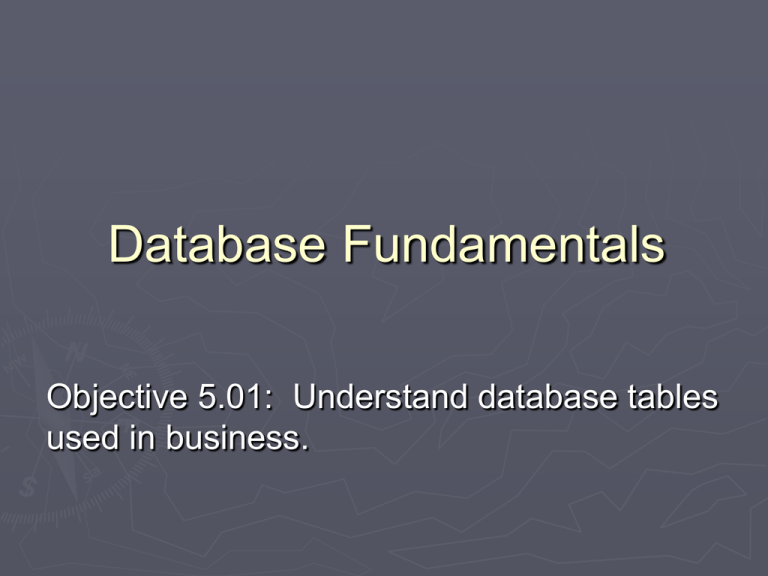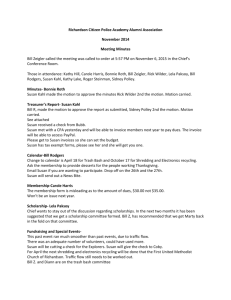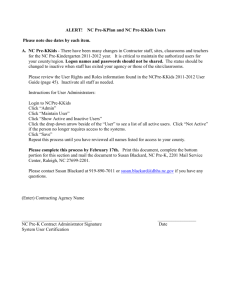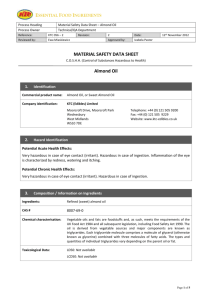Database-Fundamentals
advertisement

Database Fundamentals Objective 5.01: Understand database tables used in business. What is a database? ►A database is a tool for organizing, storing, retrieving, and communicating groups of information that have similar characteristics 5.01 Understand database tables used in business Slide 2 Examples of Business Databases ►Telephone book ►Student data ►Music ►Fingerprint database ►Dictionaries 5.01 Understand database tables used in business ► Customer data ► Real estate listings MLS listings online ► Hospital/patient data ► Inventory Barcode scanner keeps inventory in database Slide 3 What makes a database? Databases consist of four objects: 1. Tables store data in rows and columns* 2. Queries retrieve and process data 3. Forms control data entry and data views Customized manner of inputting data into a database or presenting data on a screen 4. Reports summarize and print data *In this objective, our focus is on tables 5.01 Understand database tables used in business Slide 4 Tables: the Building Blocks of all Databases ► Tables store data, so they’re essential building blocks of any database. ► All databases contain at least one table ►A •Tables organize data •Each database consists of one or more tables 5.01 Understand database tables used in business database should have a separate table for every major subject, such as for employee records or customer orders. Data should not be duplicated in multiple tables. ► Tables contain Rows called Records and Columns called Fields. Slide 5 Components of a Database Table ► Record – A group of related fields of information. Everything on one row is a record ► Field – One item or bit of information in a record; represented by a COLUMN. Comprised of entries ► Entry – Data typed into a field. Made up of characters. Example: John Doe is an entry in the name field. Also known as data. 5.01 Understand database tables used in business Slide 6 Database Tables: The Big Picture 1. Records 2. Fields 3. Entry 1. Rows – RECORDS 2. Columns - FIELDS 3. Cells - ENTRIES To calculate the number of entries in a database multiply the number of fields by the number of records. Ex. 5*26= 130 entries in this database. 5.01 Understand database tables used in business Slide 7 Discussion ► Name ► Birth date ► Social Security No. ► Street ► City ► State ► Zip ► Phone 5.01 Understand database tables used in business Each item on the left is classified as a/an: a) Table b) Record c) Field d) Entry Slide 8 Discussion ► Susan Almond ► 10/22/1985 ► 245-88-9845 ► 31 Bessemer St. ► Greensboro ► NC ► 25233 ► 336-585-5646 5.01 Understand database tables used in business Each item on the left is classified as a/an: a) Table b) Record c) Field d) Entry Slide 9 Discussion ► Susan Almond ► 10/22/1985 ► 245-88-9845 ► 31 Bessemer St. ► Greensboro ► NC ► 25233 ► 336-585-5646 5.01 Understand database tables used in business All of the information about Susan Almond is classified as a/an: a) Table b) Record c) Field d) Entry Slide 10 Discussion ► Information about multiple employees is classified as a/an: a) Table b) Record c) Field d) Entry 5.01 Understand database tables used in business Slide 11 Susan’s Record Name Bday SS Almond, Susan 10/22/1 985 245-889845 Street 31 Bessemer St City St Greensboro NC Zip Phone 25233 336-5855646 One record is displayed from the Employee Table above. The table contains 8 fields. 5.01 Understand database tables used in business Slide 12 Test your knowledge ► Using the last page of the Database Fundamentals graphic organizer, classify each database component. 5.01 Understand database tables used in business Slide 13











